NEW ORLEANS-1
(Last updated 3/15/03)
New Orleans and Louisiana have long
and convoluted histories.
The colony of New Orleans was founded
by Jean-Baptiste le Moyne, Sieur de Bienville (later Governor
of Louisiana), in 1718 on the site of a deserted Indian village
straddling the portage route between the Mississippi River and
Lake Pontchartrain. Bienville chose the site to replace Biloxi,
the first settlement in French Louisiana, in order to have a capital
with better access to the sea. The location, first seen in 1699
by Bienville and his brother Pierre (Sieur d'Iberville, founder
of the colony of Louisiana), turned out to be the closest dry
land to the Gulf along the Mississippi - even though the mouth
of the river was 110 miles away! The city - named "La Nouvelle
Orlean" for the Duc d'Orleans (Regent of France), who had
just transferred Louisiana to the 'Company of the West' formed
by John Law, a flamboyant speculator (and the Scottish Minister
of Finance for France) - was derogatorily called "Isle d'Orleans"
by its French inhabitants because of the swamps, lakes, and rivers
surrounding it; but as a result of Law's promotions, boatloads
of people, mostly from France, but also German farmers and slaves
from the French Caribbean, arrived in New Orleans to swell its
population.
New Orleans remained a French colony
until the 1763 Treaty of Paris (see below), in which France was
forced to cede Canada and all of its Louisiana territory east
of the Mississippi and north of the 'Isle of Orleans' to Great
Britain. In order to position France more advantageously in its
negotiations with GB, Louis XV had transferred the rest of his
Louisiana territory, ie, that west of the Mississippi - plus New
Orleans, to his Spanish cousin King Carlos III in the secret Treaty
of Fountainebleau the previous year; the transfer was made public
in the preamble to the ToP.
[On the face of it, the changes in
North America resulted from France's loss to GB in what was called
the 4th French and Indian War (1754-60). However that conflict
was in actuality a forerunner to, then an extension of The Seven
Years War (1756-63), the first true world war. Fought in North
America, Europe, and India, the War pitted Bourbon King Louis
XV's France, with support from Saxony, Austria, Russia, Sweden,
and Spain (after 1762, when Louis XIVth's grandson Philip ascended
to the throne) against Frederick II's Prussia, backed by Great
Britain and Hanover (as GB's King George II was its Elector).
Russia was the first of the combatants to sue for peace - in the
Treaty of St. Petersburg (1762), followed shortly afterwards by
Sweden. Peace was restored among Prussia, Austria, and Saxony
in the Treaty of Hubertusburg (1763), which marked Prussia's ascendancy
in Germany, and eventually led to its status as a world power.
And finally, through the Treaty of Paris, Spain ceded Florida
to GB in exchange for the return of Havana and its other captured
territories in Cuba, France lost most of its overseas possessions,
and Great Britain emerged as the world's major colonial empire.
(However, Britain's success proved to be extremely costly in the
long run, as its attempts to cover its war debts and pay for its
military presence in America by direct taxation of its colonists
helped to set the stage for the American Revolution.)]
New Orleans changed hands again in
1800 in the secret Treaty of San Ildefonso, shortly after Napoleon
Bonaparte's victorious Italian campaigns - which resulted in northern
Italy becoming a French puppet republic. Napoleon supposedly wanted
the Mississippi Valley as a source of supply for the island of
Hispaniola, which he intended to turn into the heart of a new
French empire in the Americas; so Napoleon negotiated French repossession
of Spanish Louisiana - including New Orleans - with Charles IV
of Spain in exchange for the "kingdom" of Etruria (which
Napoleon created from a part of Tuscany), which Charles then gave
to his son-in-law, the Duke of Parma.
The United States eventually learned
of these events when the Superintendant of NO closed travel on
the Mississippi to Americans. In response, President Jefferson
sent representatives to Paris to try to negotiate navigation rights
for the US, or the purchase of a tract of land, ie, New Orleans,
that would guarantee such rights. In the meantime, Haitian slaves
had revolted and taken control of Hispaniola (in 1801, under Toussaint
l'Ouverture), then managed (with the help of yellow fever) to
repulse the French troops sent to put down their rebellion (1802).
So in early 1803, in reply to US overtures, Napoleon - facing
renewed war with Great Britain, and with no further troops or
funds to spare - offered to sell not just NO but all of Louisiana
to the US. Jefferson, although concerned about the priority claims
of Spain under the ToSI (as first buyer if France chose to resell)
and his lack of constitutional authority to make such a purchase,
immediately accepted - and the Louisiana Purchase treaty, in which
800,000 sq mi of land extending from the Mississippi River to
the Rocky Mountains - including New Orleans - was ceded to the
US for ca $15 million, was signed on April 30, 1803.
However, according to at least some
Louisianans, US ownership of NO was not really resolved until
the Battle of New Orleans in 1815, in which Andrew Jackson and
a ragtag collection of soldiers, militia, and NO residents (including
free blacks) defeated a well-equipped British army fresh from
its triumph over Napoleon in the Peninsular Campaign (in Portugal
and Spain). They argue that if GB had won, it would have had every
reason (and strong legal necessity, in view of Spain's formal
protest of the LP under the ToSI) to convey Louisiana back to
its recent ally in the Spanish War, especially in view of Spain's
support during the War of 1812, ie, GB used Pensacola in Spanish
Florida as the naval base from which it invaded NO!
______
The heart of New Orleans is the Vieux
Carre, literally "old square," designed by Pierre LeBlond
de la Tour and laid out by the French military engineer Adrien
de Pauger in 1722. Bounded by Canal Street to the east, Rampart
Street to the north, Esplanade Avenue to the west, and Decatur
Street (and the Mississippi River) to the south, this 13 by 6
square block area - commonly known as the French Quarter, home
to Bourbon Street, Dixieland jazz, and a dozen legendary restaurants,
IS New Orleans to most tourists. The
focus of the French Quarter, in turn, is Jackson Square, named
in honor of NO's hero in the War of 1812 - originally the Place
d'Armes (under the French), then Plaza de Armas (under the Spanish),
the current design for the Square dates from 1850, the cast-iron
fence and gates (produced locally by the Pelanne brothers foundry)
from 1851; behind the Square on Chartres Street, from left to
right, the Cabildo, the St. Louis Cathedral, and the Presbytere
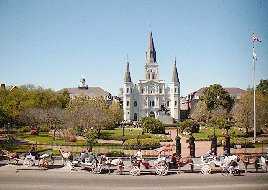 A closer view of St. Louis Cathedral
(left), dedicated to Louis IX, with a famous statue of Andrew
Jackson (Clark Mills, 1856) - supposedly the first example of
a sculpted horse balanced on its hind legs - to the left; the
old Spanish cathedral (1789-94) was partially demolished in 1849
so it could be expanded and rebuilt in its present form (1850)
- views of the Cathedral's ornately painted ceiling (center) and
its relatively simple altar (right)
A closer view of St. Louis Cathedral
(left), dedicated to Louis IX, with a famous statue of Andrew
Jackson (Clark Mills, 1856) - supposedly the first example of
a sculpted horse balanced on its hind legs - to the left; the
old Spanish cathedral (1789-94) was partially demolished in 1849
so it could be expanded and rebuilt in its present form (1850)
- views of the Cathedral's ornately painted ceiling (center) and
its relatively simple altar (right)
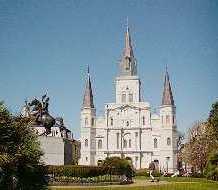
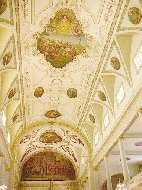
 The Cathedral Garden, also known as
Pere Antoine Square (1831; right), located behind the Cathedral
off Pirate's Alley, contains a statue of the Sacred Heart (1859)
and a white marble obelisk topped by a funerary urn, a monument
to the French sailors of the steam corvette Tonnere (who died
of yellow fever in 1857); the monument, originally located at
the Louisiana Quarantine Station 70 miles downriver, was moved
to the Garden in 1914 as a gift from France. The Cabildo (1795-9;
center) was built to house the Spanish governing body of the city,
but after serving as the site for the signing of the documents
transferring the Louisiana Purchase to the US, it became the meeting
place for the NO city council (it nearly burned to the ground
in 1988, took 5 years to restore). The Presbytere (1797-1847;
right), originally intended as the Cathedral rectory, was instead
used as the city's Court House - it became a part of the Louisiana
State Museum system in 1911
The Cathedral Garden, also known as
Pere Antoine Square (1831; right), located behind the Cathedral
off Pirate's Alley, contains a statue of the Sacred Heart (1859)
and a white marble obelisk topped by a funerary urn, a monument
to the French sailors of the steam corvette Tonnere (who died
of yellow fever in 1857); the monument, originally located at
the Louisiana Quarantine Station 70 miles downriver, was moved
to the Garden in 1914 as a gift from France. The Cabildo (1795-9;
center) was built to house the Spanish governing body of the city,
but after serving as the site for the signing of the documents
transferring the Louisiana Purchase to the US, it became the meeting
place for the NO city council (it nearly burned to the ground
in 1988, took 5 years to restore). The Presbytere (1797-1847;
right), originally intended as the Cathedral rectory, was instead
used as the city's Court House - it became a part of the Louisiana
State Museum system in 1911
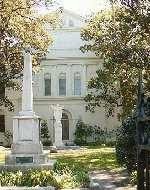

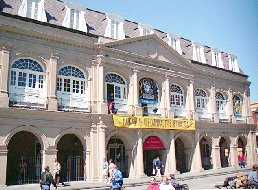 The block-long Upper and Lower (defined
in NOese, relative to the direction of the flow of the River)
Pontalba Buildings (1849-50; by local architect James Gallier
Sr) are twin structures of red brick flanking Jackson Square,
each made up of 16 row-house type units, 12 of which face the
square; as originally intended, the ground floors are still all
commercial space, the upper floors apartments, although a part
of the Lower Building, called the 1850 House, is maintained by
the Louisiana State Museum. When the apartments were built by
the Baroness Micaela (Almonaster) de Pontalba (the only child
of a Spanish grandee who married her cousin, uniting two of the
wealthiest families in Louisiana; she was eventually shot by her
father-in-law!), they incorporated a new feature - second-story
galleries with cast iron railings - that became all the rage in
the FQ and were soon seen on most of the area's buildings, both
new and old
The block-long Upper and Lower (defined
in NOese, relative to the direction of the flow of the River)
Pontalba Buildings (1849-50; by local architect James Gallier
Sr) are twin structures of red brick flanking Jackson Square,
each made up of 16 row-house type units, 12 of which face the
square; as originally intended, the ground floors are still all
commercial space, the upper floors apartments, although a part
of the Lower Building, called the 1850 House, is maintained by
the Louisiana State Museum. When the apartments were built by
the Baroness Micaela (Almonaster) de Pontalba (the only child
of a Spanish grandee who married her cousin, uniting two of the
wealthiest families in Louisiana; she was eventually shot by her
father-in-law!), they incorporated a new feature - second-story
galleries with cast iron railings - that became all the rage in
the FQ and were soon seen on most of the area's buildings, both
new and old
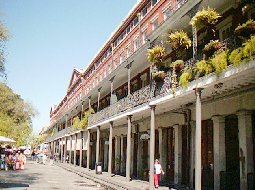
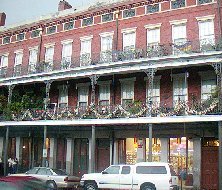 The French Market (1813-23), America's
oldest city marketplace, is a series of arcaded buildings covering
four blocks just east of Jackson Square; built after the great
NO hurricane of 1812 destroyed the original (which dated from
1771), the Market offers everything from produce, meats, and fish
- including vast arrays of local food specialties (left) - to
clothing, jewelry, and tourist souveniers of every variety (right),
although commercialism and a '70s renovation have taken their
toll on its original character
The French Market (1813-23), America's
oldest city marketplace, is a series of arcaded buildings covering
four blocks just east of Jackson Square; built after the great
NO hurricane of 1812 destroyed the original (which dated from
1771), the Market offers everything from produce, meats, and fish
- including vast arrays of local food specialties (left) - to
clothing, jewelry, and tourist souveniers of every variety (right),
although commercialism and a '70s renovation have taken their
toll on its original character
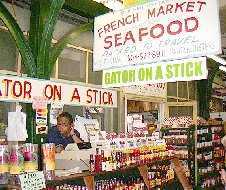
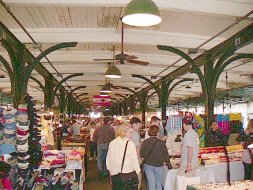 To the east of the Market lies the
Ursuline Convent (1745-53; left), the oldest building in New Orleans,
and the only one definitely known to date from the period of early
French rule in Louisiana (the others were destroyed by devastating
fires in 1788, 1792, and 1794); it and the other slightly newer
buildings around it (right) form the Archbishop Antoine Blanc
Memorial complex
To the east of the Market lies the
Ursuline Convent (1745-53; left), the oldest building in New Orleans,
and the only one definitely known to date from the period of early
French rule in Louisiana (the others were destroyed by devastating
fires in 1788, 1792, and 1794); it and the other slightly newer
buildings around it (right) form the Archbishop Antoine Blanc
Memorial complex

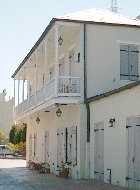 Lafitte's Blacksmith Shop (1772; left),
near the north end of Bourbon Street, is also a leftover from
the French era, its brick-between-posts type of construction introduced
to the city by early French builders; a similar looking but much
later structure in a different part of the FQ (right)
Lafitte's Blacksmith Shop (1772; left),
near the north end of Bourbon Street, is also a leftover from
the French era, its brick-between-posts type of construction introduced
to the city by early French builders; a similar looking but much
later structure in a different part of the FQ (right)
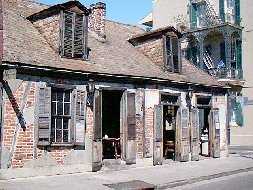
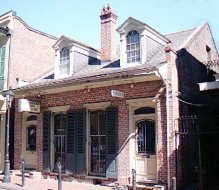 The Old Absinthe House (ca 1806; left),
on Bourbon Street, an early example of a 2-story commercial/residential
combination building, with an "entresol" (an intermediate
service floor lighted by the ground floor transoms) and a wrought
iron porch balcony - originally an import warehouse, it began
selling absinthe in 1826. A block down the street, the Old Absinthe
Bar (right) does actually contain the marble bar and acoutrements
from the OAH, moved there in 1926 when the OAH was closed during
Prohibition - a well-known NO music venue, the Bar's interior
was the setting for a Led Zeppelin album cover
The Old Absinthe House (ca 1806; left),
on Bourbon Street, an early example of a 2-story commercial/residential
combination building, with an "entresol" (an intermediate
service floor lighted by the ground floor transoms) and a wrought
iron porch balcony - originally an import warehouse, it began
selling absinthe in 1826. A block down the street, the Old Absinthe
Bar (right) does actually contain the marble bar and acoutrements
from the OAH, moved there in 1926 when the OAH was closed during
Prohibition - a well-known NO music venue, the Bar's interior
was the setting for a Led Zeppelin album cover
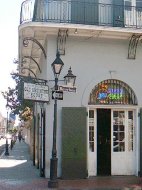
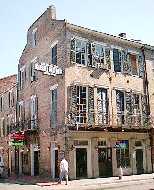 On Gov. Nicholls Street, the Greek
Doric porch of the Thierry House (1814; left) is supposedly the
oldest example of the Greek Revival style in NO - this portico
was discovered sealed up behind a wall during a 1940 restoration.
The Hermann-Grima House (1831; right; now a museum), on St Louis
Street, is one of the earliest examples of American architecture
in the Quarter - it's constructed of local faux Philadelphia brick
in the Georgian style of the Eastern seaboard
On Gov. Nicholls Street, the Greek
Doric porch of the Thierry House (1814; left) is supposedly the
oldest example of the Greek Revival style in NO - this portico
was discovered sealed up behind a wall during a 1940 restoration.
The Hermann-Grima House (1831; right; now a museum), on St Louis
Street, is one of the earliest examples of American architecture
in the Quarter - it's constructed of local faux Philadelphia brick
in the Georgian style of the Eastern seaboard

 A variety of 2- and 3-story Creole
townhouses, most from the first half of the 19th century, line
the Quarter's streets
A variety of 2- and 3-story Creole
townhouses, most from the first half of the 19th century, line
the Quarter's streets
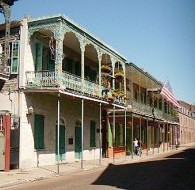

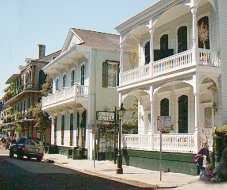 These similar 2-story commercial structures
are located near each other on Royal Street
These similar 2-story commercial structures
are located near each other on Royal Street
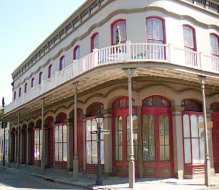
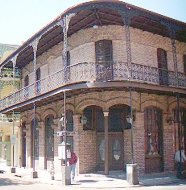 An 1850's building on Royal Street
(left), surrounded by a cast iron Cornstalk Fence (1834; center)
shipped by sea from Philadelphia; a later Corinthian-columned
Greek Revival structure (right)
An 1850's building on Royal Street
(left), surrounded by a cast iron Cornstalk Fence (1834; center)
shipped by sea from Philadelphia; a later Corinthian-columned
Greek Revival structure (right)
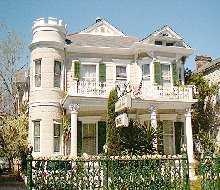
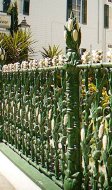
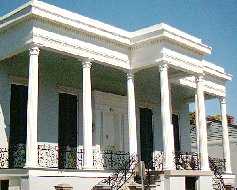 Other, simpler architectural styles
also exist in the Quarter, including the Creole cottage (left;
from the early 1800s) and the shotgun house (right; from the latter
half of the 1800s) - these examples were located a few blocks
north of Jackson Square
Other, simpler architectural styles
also exist in the Quarter, including the Creole cottage (left;
from the early 1800s) and the shotgun house (right; from the latter
half of the 1800s) - these examples were located a few blocks
north of Jackson Square
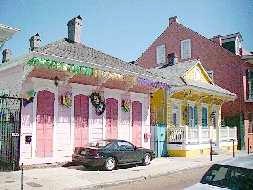
 Just north of the French Quarter across
Rampart Street - in what used to be Faubourg Tremé, the
oldest black neighborhood in the country ("free people of
color" owned property there in the early 18th century) -
lies the entrance to Louis Armstrong Park (left), soon to be part
of the New Orleans Jazz National Park. A twice-lifesize statue
of Satchmo (center; by Elizabeth Catlett), one of the most photographed
art works in NO, greets visitors near the entrance to the Park
(the red brick Firehouse Building in the background is slated
to become the Jazz Park's Visitors Center), and his bust (right)
stares out over Congo Square; originally the spot where the local
Houmas Indians celebrated their annual corn harvest, by the 1740s
the Square was a public market for African slaves (who had considerable
freedom, including weekends off, under the French Code Noir),
and by 1820 it had become famous for its gatherings of 500 or
more slaves who traded, drummed, and danced there on Sunday afternoons.
These activities gradually developed into the current Mardi Gras
Indian tribes and Second Line tradition, and also provided the
basis for New Orleans jazz and rhythm & blues
Just north of the French Quarter across
Rampart Street - in what used to be Faubourg Tremé, the
oldest black neighborhood in the country ("free people of
color" owned property there in the early 18th century) -
lies the entrance to Louis Armstrong Park (left), soon to be part
of the New Orleans Jazz National Park. A twice-lifesize statue
of Satchmo (center; by Elizabeth Catlett), one of the most photographed
art works in NO, greets visitors near the entrance to the Park
(the red brick Firehouse Building in the background is slated
to become the Jazz Park's Visitors Center), and his bust (right)
stares out over Congo Square; originally the spot where the local
Houmas Indians celebrated their annual corn harvest, by the 1740s
the Square was a public market for African slaves (who had considerable
freedom, including weekends off, under the French Code Noir),
and by 1820 it had become famous for its gatherings of 500 or
more slaves who traded, drummed, and danced there on Sunday afternoons.
These activities gradually developed into the current Mardi Gras
Indian tribes and Second Line tradition, and also provided the
basis for New Orleans jazz and rhythm & blues
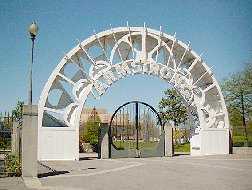
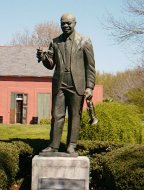
 One of the many bridges in the Park
(left) - this one leads to the Firehouse; normally confined to
a peaceful lagoon, the stream thru the Park overflowed its banks
(right) in response to over 10" of rain that had fallen the
day before - the Municipal Auditorium is just visible on the left
One of the many bridges in the Park
(left) - this one leads to the Firehouse; normally confined to
a peaceful lagoon, the stream thru the Park overflowed its banks
(right) in response to over 10" of rain that had fallen the
day before - the Municipal Auditorium is just visible on the left
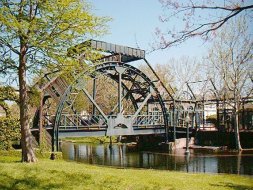
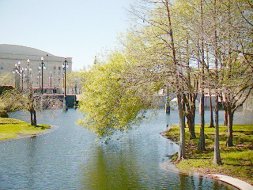 The #12 St Charles line began operation
in 1835 (as the New Orleans and Carrolton Railroad) - making it
the oldest continuously operating streetcar line in the world;
originally horse-drawn, the line was electrified in 1893, and
dozens of vintage 1923 Perley Thomas streetcars still run on its
6 mile route. Named for the avenue it travels, the line begins
on the edge of the French Quarter at St Charles and Canal, passes
Lafayette Square (left) as it runs through the Central Business
District, rounds Lee Circle, then plunges into a tunnel of live
oaks (and occasional palm trees) along the northern edge of the
Garden District (right), continues uptown thru the University
District (passing Loyola, Tulane, and Audubon Park), then turns
away from the river for a short run to Claiborne Street in what
was the old town of Carrolton (on its return trip, because of
one way streets, it rounds Lee Circle and heads up Howard to Carondelet
for its eastbound trip thru the CBD, then takes a block-long jaunt
down Canal to St Charles in order to restart its trip). At $1.25
per ride, it's a convenient and inexpensive way to play NO tourist
if you want to leave the French Quarter
The #12 St Charles line began operation
in 1835 (as the New Orleans and Carrolton Railroad) - making it
the oldest continuously operating streetcar line in the world;
originally horse-drawn, the line was electrified in 1893, and
dozens of vintage 1923 Perley Thomas streetcars still run on its
6 mile route. Named for the avenue it travels, the line begins
on the edge of the French Quarter at St Charles and Canal, passes
Lafayette Square (left) as it runs through the Central Business
District, rounds Lee Circle, then plunges into a tunnel of live
oaks (and occasional palm trees) along the northern edge of the
Garden District (right), continues uptown thru the University
District (passing Loyola, Tulane, and Audubon Park), then turns
away from the river for a short run to Claiborne Street in what
was the old town of Carrolton (on its return trip, because of
one way streets, it rounds Lee Circle and heads up Howard to Carondelet
for its eastbound trip thru the CBD, then takes a block-long jaunt
down Canal to St Charles in order to restart its trip). At $1.25
per ride, it's a convenient and inexpensive way to play NO tourist
if you want to leave the French Quarter
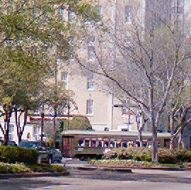
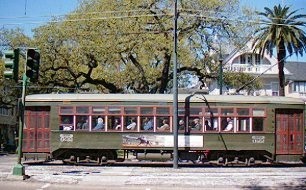 Go to New Orleans-2
| Return to Home Page
Go to New Orleans-2
| Return to Home Page




































